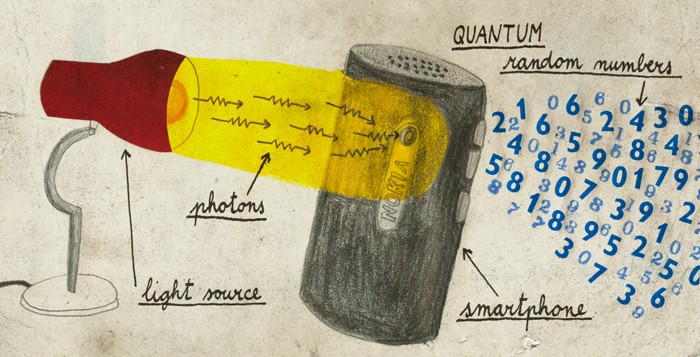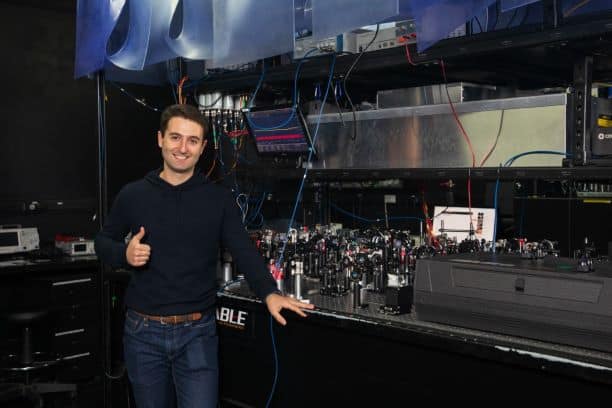Thumbs-up for randomness David Drahi in the quantum optics lab. (Courtesy: David Drahi)”>
While world events are often difficult to predict, true randomness is surprisingly hard to find. In recent years, physicists have turned to quantum mechanics for a solution, using the inherently unpredictable behavior of photons to generate the truly random numbers that underpin many modern cryptographic protocols. Now, a new study promises to make this process of quantum random number generation more accessible, by showing that it is possible to produce certifiably random numbers quickly using a system built with off-the-shelf components.
When numbers are used to securely encode information, the randomness of those numbers is crucial: a string of truly random numbers is one that a hacker can never guess. In classical physics, however, all processes – even chaotic ones – are deterministic, making true randomness impossible. To illustrate this, study lead author David Drahi, a physicist at the University of Oxford, UK, notes that classically, a simple coin flip is about as random as it gets. However, he continues, “if you know the mass of the coin, if you can see the coin, if you can look at the wind, you can predict where it is going to land”. Classical randomness is therefore limited by the existence of information about the physical process meant to produce it.
In the quantum world, in contrast, “there are these fundamentally non-deterministic processes,” says Nathan Walk, a physicist at Freie Universitat Berlin, Germany and a co-author on the study. The results of quantum measurements, he adds, are inherently unpredictable, because their outcome does not exist in any meaningful way until the measurement has been made and the wavefunction of the system has, famously, collapsed.
Certifiably random
In developing their random number generator (RNG), the study’s authors focused not only on producing randomness, but also on confirming that this randomness originates from a non-deterministic quantum process rather than some incidental classical noise in the experiment. “There is not a test you can do on a string of numbers to tell if it’s random,” Walk notes. “You can’t certify strings. But you can certify processes.”
Drahi, Walk and collaborators built such a quantum certification process – essentially an additional measurement – into their protocol for generating random numbers. They also developed rigorous theoretical proofs of its effectiveness and demonstrated that it can be implemented in practice by performing experiments using quantum light. According to Renato Renner, a physicist at ETH Zurich in Switzerland who was not affiliated with the study, such steps are important for creating a practical system. “You really want to have a device that produces some certificate, otherwise you don’t really profit from any quantum advantages,” he says.
In their experiments, the researchers send laser light (a photonic state) into one input of a beam splitter while the other input is kept void, resulting in a zero signal (a vacuum state). The consequent pair of output beams is then measured using two separate detectors. Because each photon that arrives at the beam splitter has an equal (50%) chance of being reflected or transmitted, the difference between the numbers of photons recorded by each detector is unpredictable. It is bound to be a random number, Drahi explains.
To confirm that randomness generated in this way is reliable and useful, the researchers performed another measurement on the photonic state before it reaches the beam splitter. In this certification measurement, the light signal is discarded if it would not generate the desired amount of randomness at the end of the experiment. This can happen if the laser signal contains either too few photons or too many. Too few, and the number of possible unpredictable events will be too low for the measurement to be sufficiently random. Too many, and the detectors will hit their maximum value, making the measurement fully predictable.
The inclusion of this certification measurement means that the researchers have theorized and built a device that not only produces randomness at a fast rate of 8.05 gigabits per second, but also ensures the quality of that randomness in real time. According to Feihu Xu, a physicist at the University of Science and Technology of China who was not involved in the work, this “development of a formal framework to monitor and certify the randomness” stands out even though some other ideas in the study have been explored before.
“Untrusted” light source
The researchers’ inclusion of real-time randomness certification in their experiment also has consequences for its possible future applications, because the study’s theoretical framework proves that the RNG protocol is partly independent of the devices used to implement it. For instance, the light source used can be “untrusted” – the randomness analysis is independent of any information about it. As long as the light signal passes the certification measurement, the properties of the device that produced it do not affect the quality of final randomness. This flexibility means that the group’s quantum RNG could in principle be used by “a person or a computer that knows nothing about quantum physics”, Walk notes. The numbers obtained in this fashion would be reliably random regardless of operator’s expertise, he adds, since the protocol automatically ensures its own performance.

How to make a quantum random-number generator from a mobile phone
As a bonus, the research team managed to construct their experiment using affordable off-the-shelf components – a feature that allowed Drahi to ship the experimental setup from Oxford to some of his co-authors in Moscow. “It got there and it worked,” he says, noting that it would have been virtually impossible to ship all of the components for a more exotic quantum device across a continent, have a different researcher assemble them upon arrival, and then successfully generate random numbers at the same high speed. This level of practicality, combined with the rigorous approach to confirming the randomness of their random numbers as well as generating them, sets up this study as a promising starting point for the development of real-world quantum devices providing reliably true randomness. “It could have very broad applications,” Renner concludes.
The new quantum RNG is described in Physical Review X.
